103 results
Middle school physics simulations for Google Apps
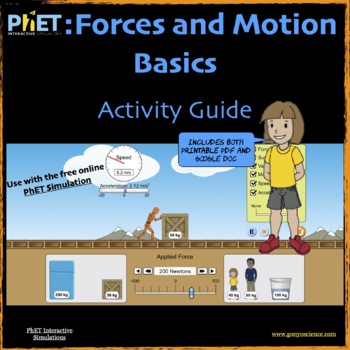
PhET Forces and Motion Basics Activity Guide
The PhET: Forces and Motion Basics Activity Guide is used along with the free *Next Generation PhET Simulation “Forces and Motion Basics”. Students will discover how balanced and unbalanced forces affect an object’s motion and then explore the relationship between force, mass, acceleration, speed, and friction on the motion of objects. The activity guide takes students through the 4 parts of the simulation: Net Force, Motion, Friction and Acceleration. Students are encouraged to make predictions
Subjects:
Grades:
6th - 10th
Types:
NGSS:
HS-PS2-2
, MS-PS2-2
, HS-PS2-1
Also included in: PhET Activity Guide Physics Bundle

PhET Projectile Motion activity guide
The PhET:Projectile Motion Activity Guide is used along with the free *Next Generation PhET Simulation on Projectile Motion. Students learn how the motion of a projectile is affected by changes in the initial height, initial speed, cannon angle, and other variables with or without the affects of wind resistance. This activity guide follows closely with the newest (HTML5) version of the PhET Projectile Motion simulation. Your students will hit the ground running without the need for a lengthy in
Subjects:
Grades:
5th - 12th
Types:
NGSS:
MS-PS2-2
Also included in: PhET Activity Guide Physics Bundle
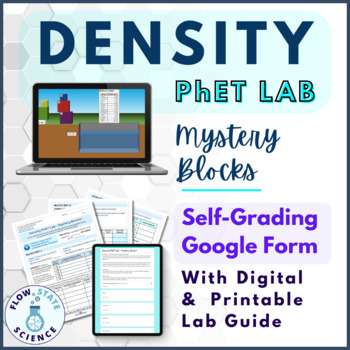
Density PhET Lab | Mystery Blocks | Self-Grading Google Form & Virtual Lab Guide
This is a self-grading, guided virtual lab that explores the relationships of volume, mass, and density using the simulation, Density Lab: Mystery Blocks by PhET! Students are challenged to identify the unknown material of mystery blocks by calculating their density to compare with the known materials in the Density Table. Students follow step-by-step instructions in the google form while tinkering with the simulation, manipulating the variables, making observations, and recording qualitative/qu
Subjects:
Grades:
6th - 9th
NGSS:
MS-PS1-2

Energy Skate Park PhET - Google Form Worksheet (distance learning)
This Energy Skate Park PhET - Google Form Worksheet is used to guide and assess students as they learn about the conservation of energy. Students will experiment with the PhET simulation and see the relationship between kinetic, potential, thermal, and total energy in a system. Students experiment with a frictionless environment as well as an environment with friction. At the end, students can play with the simulation to create their own skate park. The Energy Skate Park PhET - Google Form Works
Subjects:
Grades:
7th - 10th
Types:
CCSS:
NGSS:
MS-PS3-4
, HS-PS3-2
, MS-PS3-3
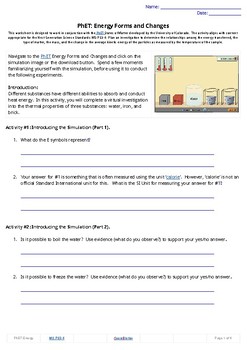
PhET - Energy Forms and Changes
This worksheet aligns with the PhET simulation of the same name, and is applicable for teaching the Next Generation Science Standards (NGSS), MS-PS3-4.
PhET, founded in 2002 by a Nobel Laureate, develops web-based math and science simulations. PhET is currently among one of the most utilized sources for science and math teachers using interactive simulations.
The Build A Molecule simulation and worksheet takes students through activities designed to build and deepen understanding of how at
Subjects:
Grades:
7th - 12th
Types:
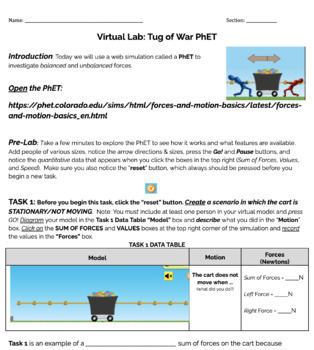
Virtual Lab: Balanced & Unbalanced Forces Tug of War PhET
Students discover the difference between balanced and unbalanced forces with a Tug of War PhET. This packet will help guide student learning. To complete the virtual lab, students write an argument (claim-evidence-reasoning) to support the claim that an unbalanced sum of forces causes a still object to start moving.
Subjects:
Grades:
6th - 11th
Types:
CCSS:
NGSS:
MS-PS2-2
, HS-PS2-1
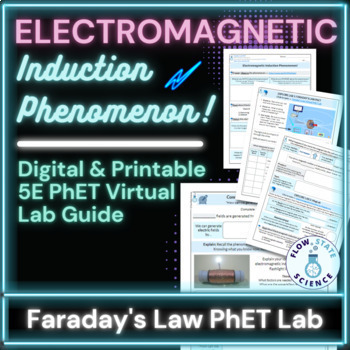
Electromagnetic Induction Phenomenon | Faraday's Law PhET Lab & Lesson
Students use this printable and digital lab guide to learn about electromagnetism and electromagnetic induction in a 5E format using the Faraday's Law PhET virtual lab simulation. Students are introduced to a phenomenon video linked on the digital resource. Then, review electromagnetism concepts by reading a linked CK12 article and taking notes. Students explore electromagnetic induction with 2 guided simulations followed by an article on electromagnetic induction (explain). By the end of the le
Subjects:
Grades:
8th - 11th
Types:
NGSS:
HS-PS2-5
, MS-PS2-3
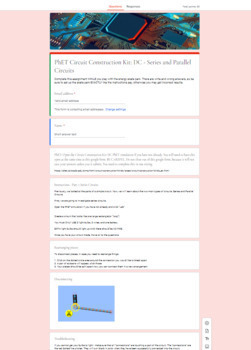
Circuit Kit: DC - SERIES AND PARALLEL PhET - Google Form Worksheet
This Circuit Kit: DC - SERIES AND PARALLEL PhET - Google Form Worksheet is used to guide and assess students as they learn about basic circuits (great for distance learning). Students will experiment with the PhET simulation and learn about the differences between SERIES and PARALLEL circuits. Students experiment with wires, resistors, batteries, and more to understand the components in a circuit. Students will also build a series and parallel circuit to measure the voltage and current under dif
Subjects:
Grades:
7th - 11th
Types:
CCSS:
NGSS:
HS-PS3-5
, HS-PS3-3

PhET Simulation Online Lab: Force and Motion
This PhET simulation virtual lab on force and motion is a great way to introduce students to the concept of force, mass, and acceleration. By the end of this activity students should be able to observe the relationship between force, mass, speed, friction, and acceleration and answer conceptual concepts. This lab consists of 9 pages, 4 parts, with a total of 28 questions. The lab is laid out as the following:Part 1: Net Force- questions 1-5Part 2: Motion- question 6-10Part 3: Friction- questions
Subjects:
Grades:
8th - 10th
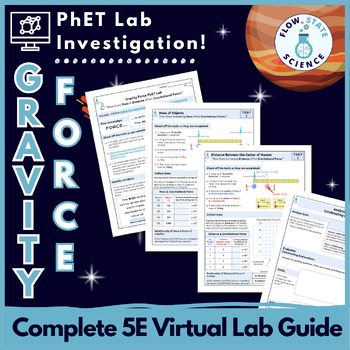
Gravity FORCE PhET | 5E Virtual Lab Guide + Key | Digital + Printable
This is an interactive digital and printable virtual lab guide for students to explore the relationships of gravity, mass and distance using the simulation, Gravity Force Lab: Basics by PhET (love their science simulations). Students follow instructions in the guide while tinkering with the simulation, manipulating the variables and observing what happens as they increase or decrease mass and distance to see how it affects the force of gravity between two bodies. Students collect data in data ta
Subjects:
Grades:
7th - 10th
NGSS:
MS-PS2-4
, HS-PS2-4

PhET: Circuit Construction Kit DC Activity Guide
The PhET: Circuit Construction Kit DC Activity Guide is used along with the free *Next Generation PhET Simulation “Circuit Construction Kit DC”. Students will discover the nature of direct current by building electrical circuits with batteries, wires, switches, bulbs, resistors, fuses, and other electrical components. In particular, students will learn about:simple circuitsopen and closed circuitsinsulators and conductorsmeasuring voltage and current with instruments (voltmeter and ammeter)the m
Subjects:
Grades:
5th - 8th
Types:
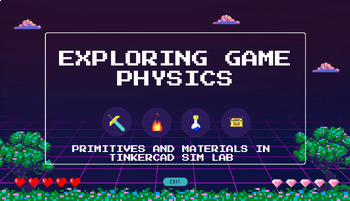
Exploring Game Physics in Tinkercad Sim Lab: Physics Challenge
This lesson is designed for a brief overview in the basics of TinkerCad SIM Lab, a recent update to Tinkercad that allows for building and manipulation with physics objects in real time. While this presentation is best for students that may have been exposed to Tinkercad basic functions, this lesson does cover enough tutorial information for students to approach it at a beginner level for the first time, or as an exploratory introduction.Lesson content covers what game physics are, how they func
Grades:
6th - 12th
Types:
CCSS:
NGSS:
HS-ETS1-2
, HS-PS2-3
, HS-ETS1-4

Molecules and Electromagnetic Radiation PhET Simulation Investigation
Students use the Molecules and Light PhET simulation to investigate how different kinds of electromagnetic radiation (microwave, infrared, visible, ultraviolet) interact with different molecules. Then, the students draw conclusions about how these types of radiation interact with matter based on the data they collect. Includes a warm-up activity where students review drawing Lewis structures, identify the 3D shapes (VSEPR shapes) of molecules, and determine their polarity.
Subjects:
Grades:
8th - 11th
Types:
NGSS:
HS-PS4-4
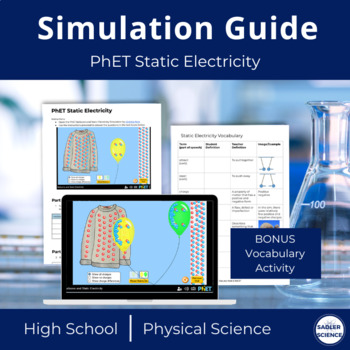
PhET Static Electricity - No Prep Simulation Guide and Vocabulary Activity
This digital static electricity activity is ZERO prep. Introduce your students to the basics of static electricity using an exploration first approach. Then, guide your students through a mini vocabulary lesson using best practices. This is an introductory activity that will help students to understand:The role of positively and negatively charged particlesAttractive and repulsive forces Essential vocabularyLimitations of models***Note: If you are interested in using best practices for science
Subjects:
Grades:
8th - 11th
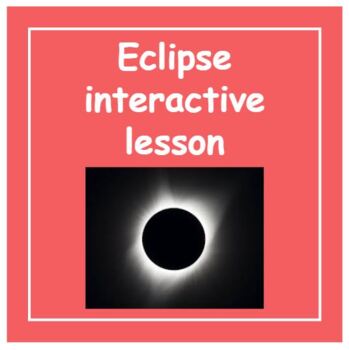
What is an eclipse? Interactive Lesson (works as sub plans, too)
This interactive lesson teaches students about eclipses. Students engage with two interactive websites using this resource. Students will even run a simulation to see what the Solar Eclipse of 2017 looked like from their location. The write-up has students working individually as they engage with two interactive websites. This activity also pairs nicely with an interactive Pear Deck slide show as a follow-up that I also have available in my Teachers Pay Teachers store both separately and as
Subjects:
Grades:
6th - 12th
Types:
NGSS:
MS-ESS1-1
Also included in: Eclipse interactive lesson and practice problems
![Preview of High Quiet Low Loud [PhET]](https://ecdn.teacherspayteachers.com/thumbitem/High-Quiet-Low-Loud-PhET--7772449-1645128088/original-7772449-1.jpg)
High Quiet Low Loud [PhET]
Investigate the differences between high and low sounds and loud and quiet sounds in terms of wave properties.This is a PhET simulation-based lab that investigates the differences between high and low sounds and loud and quiet sounds in terms of wave properties.. It utilizes either PhET sim: Waves Intro or Wave Interference.This resource is a print-friendly Google Docs file. It can be assigned via an LMS (such as Google Classroom), It can also be printed and photocopied.
Subjects:
Grades:
7th - 12th, Higher Education, Adult Education
Types:
Also included in: A Bundle of Phyz: WAVES AND SOUND

Density Simulation Sheet- Google Slides version- Calculating Volume and Density
Students calculate volume and density using an online Density Simulation and accompanying sheet. No-prep digital lesson to practice measuring mass, volume, and density. Simulation/interactive:https://pbslm-contrib.s3.amazonaws.com/WGBH/arct15/SimBucket/Simulations/densitylab/content/index.htmlMeasuring Volume with WaterUse the simulation to measure the volume of each block by submerging it in the water. Subtract column B from A and write the volume in the table. Show your work.Calculating Densit
Subjects:
Grades:
5th - 10th
Types:
NGSS:
5-PS1-1
, MS-PS1-5
, MS-PS1-1
Also included in: Density Bundle- Lab Practice Reading Interactive Project - Middle School
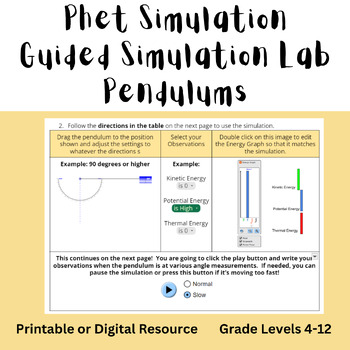
Forces and Motion Phet Simulation - Pendulum Lab on KE and PE (Uses Google Doc)
CLICK HERE to access the Pendulum Phet Simulation that is utilized for this activity. This activity focuses on Force and Motion, Energy Changes, Kinetic Energy, Potential Energy, Thermal Energy, Gravity, Friction, and Mass. This activity is best used as a digital resource, but it is a fully customizable Google Doc if you want to adjust some parts to be printable. It requires NO PREP! Students will need access the internet to utilize the Phet Simulation in order to complete this guided explora
Subjects:
Grades:
4th - 12th
Types:
NGSS:
MS-PS3-2
, 4-PS3-1
, MS-PS2-2
, MS-PS3-3
, 5-PS2-1
...
Also included in: Phet Simulation Lab - Growing Bundle (7 Activities Included)

Waves Virtual Escape Room + Google Form: NO PREP
You've Been Abducted by Aliens!A Mechanical Waves Escape Room + Google Form Activity and QuizClick here to try it out for yourself! Please test this at your school before purchasing...just to make sure your school doesn't block the interactive.How it works:The teacher provides every student the Google Form link and assigns each student either version A, B, C, or D. (Each version is the same except for the code word provided at the end).Students select their assigned version in the Google Form. T
Subjects:
Grades:
6th - 10th
Types:
![Preview of Pushing Things Around [PhET]](https://ecdn.teacherspayteachers.com/thumbitem/Pushing-Things-Around-PhET--7841325-1650308727/original-7841325-1.jpg)
Pushing Things Around [PhET]
This activity uses PhET's Forces and Motion: Basics sim to explore Newton's First and Second laws of motion. The sim's tug of war simulation is used to explore balanced and unbalanced forces, and the notion that both rest and uniform motion can occur when forces are balanced.The motion and acceleration simulations are used to establish connections between force, mass, and acceleration.I omitted a capstone analysis question here that could have cemented a = F/m based on observations made in the a
Subjects:
Grades:
7th - 12th, Higher Education, Adult Education
Types:
Also included in: A Bundle of Phyz: FORCES
![Preview of Shine a Light [PhET]](https://ecdn.teacherspayteachers.com/thumbitem/Shine-a-Light-PhET--7799380-1645896098/original-7799380-1.jpg)
Shine a Light [PhET]
Use PhET's Photoelectric Effect sim to investigate the nature of the photoelectric effect and determine the work function of an unknown metal. Recommended preparation:1. PhyzLab Springboard: The Photoelectric Effect (teacher-guided classroom discussion)2. PhyzJob: Fantasia on The Photoelectric Effect (individual assignment)Students should know the basics of the photoelectric effect before getting into this activity. The sim allows students to manipulate a photocircuit to generate data. With the
Subjects:
Grades:
7th - 12th, Higher Education, Adult Education
Types:
Also included in: A Bundle of Phyz: ATOMIC PHYSICS
![Preview of Crash and Stick [PhET]](https://ecdn.teacherspayteachers.com/thumbitem/Crash-and-Stick-PhET--7873528-1647430984/original-7873528-1.jpg)
Crash and Stick [PhET]
In this activity you will compare the momentum of a system before and after an inelastic collision. During remote teaching / distance learning (RT;DL), this PhET-fueled activity had to stand in for a more traditional conservation of momentum lab. With in-person learning, this serves as a nice precursor to the hands-on lab activity.The included Google Sheet Data Table could be used for an in-class, hands-on inelastic collisions lab as well.IncludesStudent document (print-friendly Google Docs file
Subjects:
Grades:
7th - 12th, Higher Education, Adult Education
Types:
Also included in: A Bundle of Phyz: MOMENTUM
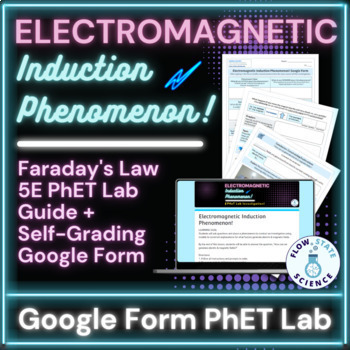
Electromagnetic Induction Phenomenon PhET Lab | Self-Grading Google Form Lesson
This is a self-guided, auto-graded lesson for students to review electromagnetism concepts to understand electromagnetic induction using a Google Form. The Form is preloaded with feedback, guiding images, note-taking prompts (digital and print-ready handout included), readings and a phenomenon video clip. Students begin exploring electromagnetic induction by asking questions about a phenomenon video. A short review with notes and reading ensures students have prior knowledge of electromagnetism
Subjects:
Grades:
8th - 11th
Types:
NGSS:
HS-PS2-5
, MS-PS2-3
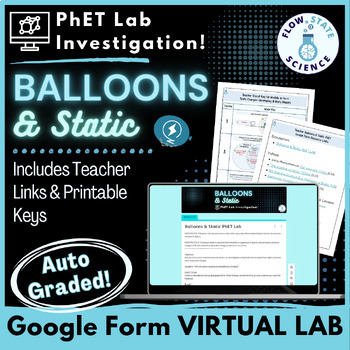
Balloons & Static PhET Lab | Auto Graded Google Form Lesson | NGSS PS2-3
This complete & comprehensive Google Form lesson engages students with a cute/silly phenomenon video of balloons, static and a cat. Students describe what they wonder about it and how they think the phenomenon works (cause & effect). Students learn important concepts by reading about electric forces & electric charge from CK12 and watching a 3 minute TEDed video (all linked in the form lesson) to reference atoms, charges, conductors, insulators, charging methods and polarization. Stu
Subjects:
Grades:
8th - 11th
Types:
NGSS:
HS-PS3-2
, MS-PS2-3
, MS-PS3-2
, HS-PS2-4
, HS-PS3-5
Showing 1-24 of 103 results





